|
|
Advertisement:
|
|
ABIT IS7 with Game Accelerator |
|
Join the community - in the OCAU Forums!
|
Overclocking, Conclusions
OVERCLOCKING
Our next target was to find out the IS7’s maximum overclocking headroom with conventional air-cooling. As all retail Pentium 4 CPUs have a locked multiplier, the challenge for P4 overclocking is to find the best balance between front-side-bus frequency, CPU voltage and RAM timings. In order to avoid the memory and memory controller becoming the bottleneck we set it via SPD to relaxed default timings (2.5-4-4-8) and disabled the ABIT Game Accelerator. Additional voltage is always necessary to reach the frequency maximum, but how much depends on the individual processor and the quality of the motherboard circuitry. Setting the voltage too low doesn’t have the desired impact on the processor’s overclocking headroom, setting it too high can have an adverse impact through the increased heat output - and at the end might even kill the CPU. In that respect we definitely do not recommend to utilize the full range of CPU voltage options the IS7 BIOS offers. 1.90 volts are definitely very dangerous territory for an air-cooled Pentium 4. We found that with a voltage of 1.80 and above both our Pentium 4 “C” samples would not allow booting into Windows even at default FSB frequency.
We first tried a March 2003 production Costa Rica P4 3.0 GHz “C” used already for our IS7 performance tests. After trying numerous FSB frequencies and voltages combinations we finally managed to achieve 15 x 253.4 MHz ~ 3801 MHz.
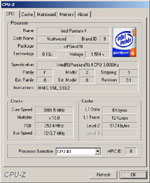
The regular aircooled overclocking range of a Pentium 4 “B” or “C” is between 600 and 800 MHz on top of the default frequency. The already by default higher clocked varieties like our 3.0 GHz have naturally a little less headroom and are often closer to 600 MHz than to 900 MHz. The 3800 MHz we achieved with the IS7 are therefore a good result and speak for the quality of the board’s circuitry and the potential of the new Pentium 4 “C” series. Remarkable is also that the FSB and the memories were running synchronously with a ratio of 1:1. The front side bus and our TwinMOS PC 3700 / DDR 466 memory modules were both running at 253 MHz! Remarkable is also that this was achieved at 1.584 volt which is close to the 3.0 GHz default voltage. In general the “C” type Pentium 4 seem to reach their maximum headroom already between 1.60~1.65 whereas the “B” type processor with the 533 MHz system bus often need 1.70~1.75 to reach the highest possible CPU frequency.
The relatively high multiplier of 15 makes it difficult to reach extreme FSB frequencies with the Pentium 3.0 GHz “C”. Our feeling was that at 15 x 153 MHz the CPU was at the end, but the IS7 Northbridge had a little way to go still. To find out how far the IS7 would go on the front-side-bus we changed to a May production Philippine 2.6 GHz “C”. With a multiplier of 13 a 2.6 GHz should allow for higher FSB frequencies if our theory was right that the 253 MHz achieved with the 3.0 GHz were the CPU and not the IS7 limit. For our second overclocking attempt with the 2.6 GHz we kept the RAM at relaxed SPD timings and the ABIT Game Accelerator disabled. The FSB to RAM ratio was set to 5:4, because the memory certainly would not run above 260 MHz. With the voltage increased to 1.65 volt we hit the wall at 13 x 278 MHz ~ 3614 MHz. Anything above this resulted in the dreaded BSOD. To have the CPU running 1000 MHz above its default speed is certainly already an outstanding result, but we did not yet give up. After many hours of experimenting and investigating we found out that the IS7 Northbridge heatsink doesn’t seem to provide enough cooling for FSB frequencies near and above 280 MHz. Although the IS7 fan seems to be up to the job, the heatsink is too small to absorb the much increased heat output when the Northbridge is running above 280 MHz. We removed the HSF combo, replaced the pinkish thermal pad with Artic Silver and wired a huge aluminum heatsink on the Northbridge.
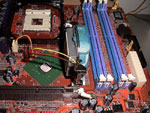 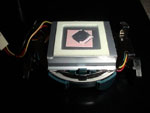 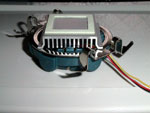
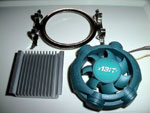 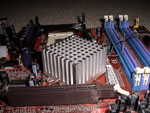 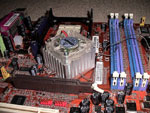
The new heatsink was roughly 5 times the size of the stock IS7 heatsink. The improved Northbridge cooling gave us another 10 MHz, taking our 2.6 GHz Pentium 4 to an eye-popping 13 x 288 MHz ~ 3736 MHz. That’s an amazing 1136 MHz on top of the stock frequency - with air-cooling.
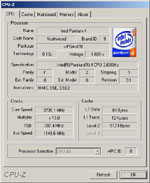
Our last overclocking challenge was to find out the maximum memory bandwidth achievable with our IS7-G sample and our aircooled P4 2.6 GHz. The 3.0 GHz was not used for this test, because a multiplier of 15 does not allow reaching extreme front-side-bus frequencies unless the CPU is sub-zero cooled. We initially set the FSB:RAM ratio to 1:1 and pushed the CPU and RAM frequency synchronous up 250 MHz achieving a buffered bandwidth of around 6000 MB/sec. We then changed to a 5:4 because above 255 MHz our TwinMOS PC 3700 became unstable. We also increased the RAM voltage from 2.7 (default) to maximum possible 2.8 volt. We finally reached a buffered bandwidth of 6226 MB/sec with the P4 2.6 GHz running at 13x283 = 3679 MHz and the memory asynchronous running at 226 MHz. The memory was set to 2.0-3-2-6 and ABIT’s Game Accelerator was enabled. Probably a Pentium 4 2.4 GHz, with its lower multiplier, would have allowed us to go even a little higher with the RAM frequency with a 5:4 ratio and to push the memory bandwidth even further.
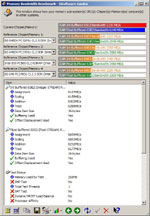
Our target was to show the maximum IS7 overclocking headroom regardless of stability. All the achieved maximum frequencies had to be lowered by 100~150 MHz for stability. Our results show that the IS7 and the new Pentium 4 “C” are a matching couple. The IS7 4-phase power regulation is certainly contributing to the IS7’s outstanding overclocking potential and stability.
CONCLUSION
ABIT’s IS7 series of 865PE chipset based motherboards has it all: best in class performance, all possible features, huge overclocking potential and attractive pricing. We also found that ABIT’s new “Game Accelerator” technology delivers a mighty punch on overall system performance. It not only puts the IS7 ahead of the competition but also on par with more expensive 875P boards. The IS7 with ABIT’s “Game Accelerator” and the new Pentium 4 “C” are a couple made in heaven and a top choice for anybody looking for a high-end gaming system.
|
|
Advertisement:
All original content copyright James Rolfe.
All rights reserved. No reproduction allowed without written permission.
Interested in advertising on OCAU? Contact us for info.
|

|


